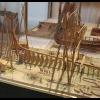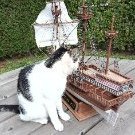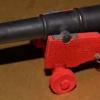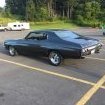-
Posts
3,084 -
Joined
-
Last visited
Reputation Activity
-
 Jaager got a reaction from mtaylor in Early use of cannon at sea
Jaager got a reaction from mtaylor in Early use of cannon at sea
Mark,
I think this is a lot more involved.
If the projectile was frozen in place and the charge ignited, the gun would not move. It would be a bomb and if it remained intact, a pressurized vessel.
The force of the recoil is equal to the mass of the projectile times the gas expansion velocity squared (while the projectile is in the system).
The rate of gas generation - the gas pressure - has a more significant effect on the projectile. Recoil or no recoil, the gas pressure in the chamber does not change.
Flames coming out of the mouth of the cannon before the projectile = a poor fit and much loss of pressure pushing it.
Flames coming out long after the projectile has left = slow and inefficient generation of gas, gas that is pushing against atmosphere instead of a solid.
-
 Jaager got a reaction from mtaylor in Early use of cannon at sea
Jaager got a reaction from mtaylor in Early use of cannon at sea
There is more movement than that in the visible range. The atoms are what is actually being subjected to the force.
I think that a segment about an F86 in Korea demonstrates some of the forces. There was something like 6 or 8 50cal mounted in the nose. A first generation pilot said that they had to be careful when chasing a MIG, not to fire too soon. Firing the guns slowed the F86 down enough that the MIG could pull away. The shipboard cannon would impart rearward force on the side of the ship. If the structure held, that force would be transferred to the whole ship. The ship would move backward. It might be difficult to measure and it might not be significant, but I suspect that in a stern chase, a fixed gun firing would widen the gap between two ships enough to matter.
-
 Jaager got a reaction from Canute in Early use of cannon at sea
Jaager got a reaction from Canute in Early use of cannon at sea
Mark,
I think this is a lot more involved.
If the projectile was frozen in place and the charge ignited, the gun would not move. It would be a bomb and if it remained intact, a pressurized vessel.
The force of the recoil is equal to the mass of the projectile times the gas expansion velocity squared (while the projectile is in the system).
The rate of gas generation - the gas pressure - has a more significant effect on the projectile. Recoil or no recoil, the gas pressure in the chamber does not change.
Flames coming out of the mouth of the cannon before the projectile = a poor fit and much loss of pressure pushing it.
Flames coming out long after the projectile has left = slow and inefficient generation of gas, gas that is pushing against atmosphere instead of a solid.
-
 Jaager got a reaction from Canute in Early use of cannon at sea
Jaager got a reaction from Canute in Early use of cannon at sea
There is more movement than that in the visible range. The atoms are what is actually being subjected to the force.
I think that a segment about an F86 in Korea demonstrates some of the forces. There was something like 6 or 8 50cal mounted in the nose. A first generation pilot said that they had to be careful when chasing a MIG, not to fire too soon. Firing the guns slowed the F86 down enough that the MIG could pull away. The shipboard cannon would impart rearward force on the side of the ship. If the structure held, that force would be transferred to the whole ship. The ship would move backward. It might be difficult to measure and it might not be significant, but I suspect that in a stern chase, a fixed gun firing would widen the gap between two ships enough to matter.
-
 Jaager got a reaction from Canute in Early use of cannon at sea
Jaager got a reaction from Canute in Early use of cannon at sea
Mark,
I suspect that the reasoning behind fixed guns is specious. I remember all those pesky force vector lines from Physics. I believe that the reverse direction force would be at the point of attachment of the gun to the ship. Very little was probably redirected to the back of the projectile. This does not mean that the time frame for the development of tactics for the use of guns at sea was any different. What was believed to be true the determining factor. The later method of allowing recoil and the dispersion of the reverse force over multiple points of attachment probably saved wear and tear on the body of the vessel.
Another thought: at the point of combustion, the force is spherical. Would not some of the compression of the atoms of the breech be converted to heat?
-
 Jaager got a reaction from 42rocker in Byrne's Saw Reference (also good for other desktop hobby saws)
Jaager got a reaction from 42rocker in Byrne's Saw Reference (also good for other desktop hobby saws)
This is straight out of my head, so no pictures.
Most table saws that can do a rip cut that is other than 90 degree vertical - tilt the blade.
The Byrnes saw holds the blade vertical and tilts the table - the right of the blade part of the table.
Kurt and No Idea suggest that because of gravity and friction, the wood can move away from the blade -because it mostly rests on an angled surface.
They mimic the standard table saw by tilting the blade, and making the accessory table horizontal. The rest of the saw goes with the blade.
The saw comes on its own base. A heavy one. They place wedges under the base to angle it up. I would want a stop at the right side edge to keep the saw from sliding.
My suggestion is more elaborate and only makes sense if a whole lot of beveled ripping is going to be done, and if several angles are involved.
My picture:
Lay a book flat on a table. Turn it so that the top of the book is facing you and the spine is on your right. Lift the front cover.
Imagine a small version of the saw sitting on the top cover. The cover is lifted until the right side saw table accessory is horizontal.
Use plywood to make the two book covers. Use a full size piano hinge as the book spine. There are holes in each corner of the saw base.
Fix the saw base to the top piece of plywood. As heavy as the saw is, I think two pieces of 1/2" ply will be needed. The bottom needs to be wider than the top - enough beyond the hinge the the whole assembly does not flip sideways.
The threaded rod and nut are not needed actually. A block of wood, square even will hold the top cover at the angle. A way to fix it in place would probably be a good idea.
-
 Jaager got a reaction from Baker in Early use of cannon at sea
Jaager got a reaction from Baker in Early use of cannon at sea
Mark,
I suspect that the reasoning behind fixed guns is specious. I remember all those pesky force vector lines from Physics. I believe that the reverse direction force would be at the point of attachment of the gun to the ship. Very little was probably redirected to the back of the projectile. This does not mean that the time frame for the development of tactics for the use of guns at sea was any different. What was believed to be true the determining factor. The later method of allowing recoil and the dispersion of the reverse force over multiple points of attachment probably saved wear and tear on the body of the vessel.
Another thought: at the point of combustion, the force is spherical. Would not some of the compression of the atoms of the breech be converted to heat?
-
 Jaager got a reaction from Mark P in Early use of cannon at sea
Jaager got a reaction from Mark P in Early use of cannon at sea
Mark,
I think this is a lot more involved.
If the projectile was frozen in place and the charge ignited, the gun would not move. It would be a bomb and if it remained intact, a pressurized vessel.
The force of the recoil is equal to the mass of the projectile times the gas expansion velocity squared (while the projectile is in the system).
The rate of gas generation - the gas pressure - has a more significant effect on the projectile. Recoil or no recoil, the gas pressure in the chamber does not change.
Flames coming out of the mouth of the cannon before the projectile = a poor fit and much loss of pressure pushing it.
Flames coming out long after the projectile has left = slow and inefficient generation of gas, gas that is pushing against atmosphere instead of a solid.
-
 Jaager got a reaction from Chuck Seiler in Early use of cannon at sea
Jaager got a reaction from Chuck Seiler in Early use of cannon at sea
Mark,
I suspect that the reasoning behind fixed guns is specious. I remember all those pesky force vector lines from Physics. I believe that the reverse direction force would be at the point of attachment of the gun to the ship. Very little was probably redirected to the back of the projectile. This does not mean that the time frame for the development of tactics for the use of guns at sea was any different. What was believed to be true the determining factor. The later method of allowing recoil and the dispersion of the reverse force over multiple points of attachment probably saved wear and tear on the body of the vessel.
Another thought: at the point of combustion, the force is spherical. Would not some of the compression of the atoms of the breech be converted to heat?
-
 Jaager got a reaction from iMustBeCrazy in Early use of cannon at sea
Jaager got a reaction from iMustBeCrazy in Early use of cannon at sea
Mark,
I suspect that the reasoning behind fixed guns is specious. I remember all those pesky force vector lines from Physics. I believe that the reverse direction force would be at the point of attachment of the gun to the ship. Very little was probably redirected to the back of the projectile. This does not mean that the time frame for the development of tactics for the use of guns at sea was any different. What was believed to be true the determining factor. The later method of allowing recoil and the dispersion of the reverse force over multiple points of attachment probably saved wear and tear on the body of the vessel.
Another thought: at the point of combustion, the force is spherical. Would not some of the compression of the atoms of the breech be converted to heat?
-

-

-
 Jaager got a reaction from Chuck Seiler in Acrylic clear over India Ink
Jaager got a reaction from Chuck Seiler in Acrylic clear over India Ink
This discussion has me wondering a bit more about scale effect as it applies to color.
I am wondering if @ 1:600 the black would look better if it were actually a very dark grey.
If it is an Atlantic Ocean vessel, just a slight hint of green in the dark grey?
-
 Jaager got a reaction from mtaylor in Acrylic clear over India Ink
Jaager got a reaction from mtaylor in Acrylic clear over India Ink
This discussion has me wondering a bit more about scale effect as it applies to color.
I am wondering if @ 1:600 the black would look better if it were actually a very dark grey.
If it is an Atlantic Ocean vessel, just a slight hint of green in the dark grey?
-
 Jaager got a reaction from Bob Cleek in Acrylic clear over India Ink
Jaager got a reaction from Bob Cleek in Acrylic clear over India Ink
This discussion has me wondering a bit more about scale effect as it applies to color.
I am wondering if @ 1:600 the black would look better if it were actually a very dark grey.
If it is an Atlantic Ocean vessel, just a slight hint of green in the dark grey?
-
 Jaager got a reaction from RichardG in Acrylic clear over India Ink
Jaager got a reaction from RichardG in Acrylic clear over India Ink
This discussion has me wondering a bit more about scale effect as it applies to color.
I am wondering if @ 1:600 the black would look better if it were actually a very dark grey.
If it is an Atlantic Ocean vessel, just a slight hint of green in the dark grey?
-
 Jaager got a reaction from Canute in Acrylic clear over India Ink
Jaager got a reaction from Canute in Acrylic clear over India Ink
This discussion has me wondering a bit more about scale effect as it applies to color.
I am wondering if @ 1:600 the black would look better if it were actually a very dark grey.
If it is an Atlantic Ocean vessel, just a slight hint of green in the dark grey?
-
 Jaager got a reaction from mtaylor in Acrylic clear over India Ink
Jaager got a reaction from mtaylor in Acrylic clear over India Ink
India ink is very small particles in water - maybe graphite? - carbon anyway. When I was a pup, a drop on a microscope slide was a method of displaying brownian motion.
It is essentially a dye. It penetrated porous surfaces and stays behind when the water dries. Plastic (your type -styrene) has no pores. The ink is just a dirt layer on the surface. There is no chemical reaction involved. Paint involves a chemical reaction. Your clear finish also involves a chemical reaction.
From your description - a speculation: the carbon particles suspend in the water solvent of the poly finish and interfere with the polymerization reaction. It may never dry or if dry the incomplete reaction may leave mostly poly monomers which are essentially just another dirt layer. In this case, the product is named after a reaction that does not occur, so it is nor poly at all.
-
 Jaager got a reaction from Ryland Craze in New member and new ship modeler
Jaager got a reaction from Ryland Craze in New member and new ship modeler
D.,
If you have not already done so, I suggest that you read the pinned post just above this one:
For Beginners -- A Cautionary Tale
May your attendance here be long and rewarding.
-
 Jaager got a reaction from mtaylor in New member and new ship modeler
Jaager got a reaction from mtaylor in New member and new ship modeler
D.,
If you have not already done so, I suggest that you read the pinned post just above this one:
For Beginners -- A Cautionary Tale
May your attendance here be long and rewarding.
-
 Jaager got a reaction from Danstream in New member and new ship modeler
Jaager got a reaction from Danstream in New member and new ship modeler
D.,
If you have not already done so, I suggest that you read the pinned post just above this one:
For Beginners -- A Cautionary Tale
May your attendance here be long and rewarding.
-
 Jaager got a reaction from bruce d in New member and new ship modeler
Jaager got a reaction from bruce d in New member and new ship modeler
D.,
If you have not already done so, I suggest that you read the pinned post just above this one:
For Beginners -- A Cautionary Tale
May your attendance here be long and rewarding.
-
 Jaager got a reaction from mtaylor in Edge of Deck Plank Layout: Spirketting, Waterway, Margin Plank
Jaager got a reaction from mtaylor in Edge of Deck Plank Layout: Spirketting, Waterway, Margin Plank
John,
Your diagrams in post #1 and post #4 are quick and dirty POB kit shortcuts .
The final appearance would be essentially the same as actual practice. But what you show is very different from actual practice.
The actual waterway is a thick and wide timber, with 5 surfaces in cross section. It butts against the inside face of the top timbers. It has a slope or bevel on the top inside corner.
The kit saves itself lot of work by calling a triangular strip of wood - the waterway. It is just the bevel of the waterway.
The margin plank ( and the waterway ) sat on a mortise/notch cut into the top of the deck beams. The margin plank(s) are about twice thickness of the deck planks. They add strength at the side and lock the waterway in place. On the surface, none of this is seen. The kit uses deck planking as the margin plank. I hope your drawing is not to scale. The margin plank needs to be wide enough to take the nibs. The deck planks should be 10" wide at the maximum. A smaller ship may only have one strake of margin planking?
The spirketting as a sort of inside wale. It provides strength and is also subject to stress from the forward cannon trucks. It actually sits on the waterway and reaches the underside of the gun port sills.
The inside bulwark planking starts above the spirketting and is maybe about one half the thickness.
In Gary's post #3, the four strakes of top and butt are on the main (gun) deck of a frigate. They lay under the monster size guns. I can imagine the on recoil that those guns may hop as well as jerk on the rope springs and ring bolts at the spirketting. Planks with added thickness and interlocked joinery for the stress there. I doubt that is detail would apply to Lady Nelson.
-
 Jaager got a reaction from Duanelaker in Edge of Deck Plank Layout: Spirketting, Waterway, Margin Plank
Jaager got a reaction from Duanelaker in Edge of Deck Plank Layout: Spirketting, Waterway, Margin Plank
John,
Your diagrams in post #1 and post #4 are quick and dirty POB kit shortcuts .
The final appearance would be essentially the same as actual practice. But what you show is very different from actual practice.
The actual waterway is a thick and wide timber, with 5 surfaces in cross section. It butts against the inside face of the top timbers. It has a slope or bevel on the top inside corner.
The kit saves itself lot of work by calling a triangular strip of wood - the waterway. It is just the bevel of the waterway.
The margin plank ( and the waterway ) sat on a mortise/notch cut into the top of the deck beams. The margin plank(s) are about twice thickness of the deck planks. They add strength at the side and lock the waterway in place. On the surface, none of this is seen. The kit uses deck planking as the margin plank. I hope your drawing is not to scale. The margin plank needs to be wide enough to take the nibs. The deck planks should be 10" wide at the maximum. A smaller ship may only have one strake of margin planking?
The spirketting as a sort of inside wale. It provides strength and is also subject to stress from the forward cannon trucks. It actually sits on the waterway and reaches the underside of the gun port sills.
The inside bulwark planking starts above the spirketting and is maybe about one half the thickness.
In Gary's post #3, the four strakes of top and butt are on the main (gun) deck of a frigate. They lay under the monster size guns. I can imagine the on recoil that those guns may hop as well as jerk on the rope springs and ring bolts at the spirketting. Planks with added thickness and interlocked joinery for the stress there. I doubt that is detail would apply to Lady Nelson.
-
 Jaager got a reaction from bruce d in Edge of Deck Plank Layout: Spirketting, Waterway, Margin Plank
Jaager got a reaction from bruce d in Edge of Deck Plank Layout: Spirketting, Waterway, Margin Plank
John,
Your diagrams in post #1 and post #4 are quick and dirty POB kit shortcuts .
The final appearance would be essentially the same as actual practice. But what you show is very different from actual practice.
The actual waterway is a thick and wide timber, with 5 surfaces in cross section. It butts against the inside face of the top timbers. It has a slope or bevel on the top inside corner.
The kit saves itself lot of work by calling a triangular strip of wood - the waterway. It is just the bevel of the waterway.
The margin plank ( and the waterway ) sat on a mortise/notch cut into the top of the deck beams. The margin plank(s) are about twice thickness of the deck planks. They add strength at the side and lock the waterway in place. On the surface, none of this is seen. The kit uses deck planking as the margin plank. I hope your drawing is not to scale. The margin plank needs to be wide enough to take the nibs. The deck planks should be 10" wide at the maximum. A smaller ship may only have one strake of margin planking?
The spirketting as a sort of inside wale. It provides strength and is also subject to stress from the forward cannon trucks. It actually sits on the waterway and reaches the underside of the gun port sills.
The inside bulwark planking starts above the spirketting and is maybe about one half the thickness.
In Gary's post #3, the four strakes of top and butt are on the main (gun) deck of a frigate. They lay under the monster size guns. I can imagine the on recoil that those guns may hop as well as jerk on the rope springs and ring bolts at the spirketting. Planks with added thickness and interlocked joinery for the stress there. I doubt that is detail would apply to Lady Nelson.












.thumb.jpg.c459ce4140b54c12eddb8eedfd446df3.jpg)

